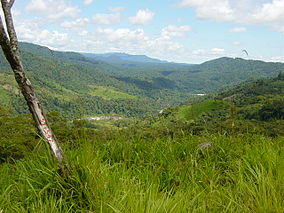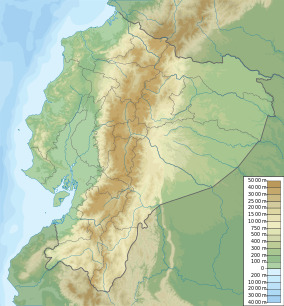| Sangay National Park | |
|---|---|
| Parque nacional Sangay | |
IUCN category II (national park) | |
 Sangay National Park | |
| Location | Ecuador |
| Coordinates | 1°50′S 78°20′W / 1.833°S 78.333°W |
| Area | 5,177.65 km2 (1,999.10 sq mi) |
| Established | 1979 |
| Type | Natural |
| Criteria | vii, viii, ix, x |
| Designated | 1983 (7th session) |
| Reference no. | 260 |
| State Party | Ecuador |
| Region | Latin America and the Caribbean |
| Endangered | 1992–2005 |
Sangay National Park (Spanish: Parque Nacional Sangay) is a national park located in the Morona Santiago, Chimborazo and Tungurahua provinces of Ecuador. The park contains two active volcanoes (Tungurahua and Sangay), one extinct volcano El Altar (Kapak Urku), and ecosystems ranging from tropical rainforests to glaciers.
The park has been listed as a UNESCO World Heritage Site since 1983. In 1992, it was added to the List of World Heritage in Danger due to illegal poaching, extensive grazing, unplanned road construction and encroachment of the park's perimeter. It was removed from the UNESCO list of endangered sites in 2005.
Fauna
The National Park is an important refuge for rare species of the Andes, like mountain tapir and spectacled bear. Especially for the mountain tapir, the park is one of the most important strongholds.[1] In the forests below live spectacled bears, giant otter, jaguar, ocelot, margay, Brazilian tapir, white-tailed deer (Odocoileus virginianus ustus), little red brocket deer and Northern pudu. About 300-400 bird species inhabit the Park,[2] and it has been recognised as an Important Bird Area (IBA) by BirdLife International.[3]
The cougar and pampas cat have been recorded in the park as well.[4]
In 2016, a new Pristimantis species was described from the park's cloud forest.[5]
Gallery
See also
References
- ^ Downer, CC. (1996). "The mountain tapir, endangered 'flagship' species of the high Andes". Oryx. 30 (1): 45–58. doi:10.1017/s0030605300021384. Archived from the original on 2011-11-27.
- ^ UNEP & WCMC: SANGAY NATIONAL PARK ECUADOR, (letztes update 2005) PDF
- ^ "Sangay National Park". BirdLife Data Zone. BirdLife International. 2021. Retrieved 21 January 2021.
- ^ Nowell, K.; Jackson, P. (1996). Wild Cats: Status Survey and Conservation Action Plan (PDF). Gland, Switzerland: IUCN.
- ^ Brito M, J., Ojala-Barbour, R., Batallas R, D. and Almendáriz C, A. (2016). "A New Species of Pristimantis (Amphibia: Strabomantidae) from the Cloud Forest of Sangay National Park, Ecuador". Journal of Herpetology. 50 (2): 337–344. doi:10.1670/13-103.
External links
- http://logronoturismo.com/
- Sangay National Park on UNESCO World Heritage Centre
- Jean-Claude Petit Butterflies of Sangay National Park
- Spectacled Bear Research and Conservation Project in Sangay National Park by Fundación Cordillera Tropical



